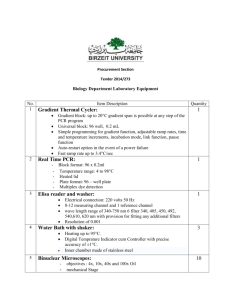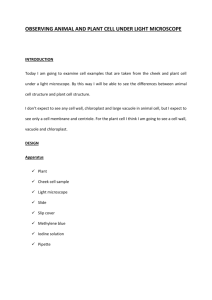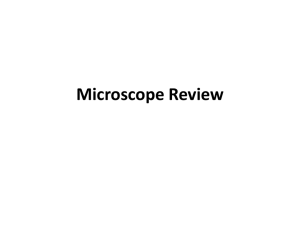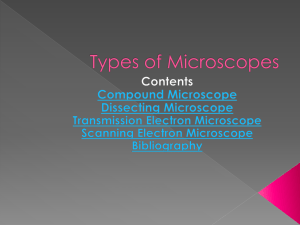Dissecting/Stereo Microscope
advertisement
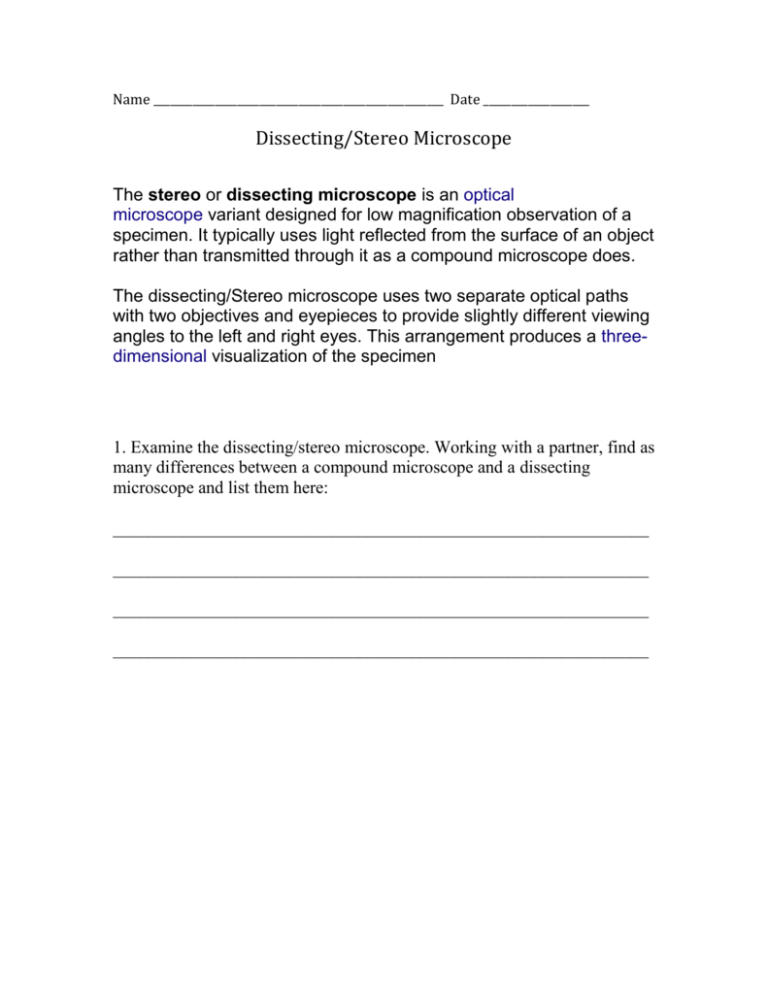
Name ____________________________________________________ Date ___________________ Dissecting/Stereo Microscope The stereo or dissecting microscope is an optical microscope variant designed for low magnification observation of a specimen. It typically uses light reflected from the surface of an object rather than transmitted through it as a compound microscope does. The dissecting/Stereo microscope uses two separate optical paths with two objectives and eyepieces to provide slightly different viewing angles to the left and right eyes. This arrangement produces a threedimensional visualization of the specimen 1. Examine the dissecting/stereo microscope. Working with a partner, find as many differences between a compound microscope and a dissecting microscope and list them here: _____________________________________________________________ _____________________________________________________________ _____________________________________________________________ _____________________________________________________________ 2. Fill in what these parts do: Microscope Part a. Eye Piece b. Rotating Objects c. Stage plate d. Focus knob e. Lighting controls Function 3. Choose an object or an organism to explore under the stereo microscope on the lab desk. 4. Sketch the organisms seen under the stereo microscope. Follow the rules of scientific drawing: a. Draw only what you see! Do not include what you think you should see. b. All drawings must be done in pencil ONLY. c. Drawings must be large and clear so that features can be easily distinguished. d. Always use distinctive drawings, do not sketch. e. Give your drawings a title, write the magnification and label important features. Title ___________________________ Magnification _________________ Title ___________________________ Magnification _________________ Title ___________________________ Magnification ________________ Title ___________________________ Magnification _________________ Short History of the Microscope Pre-1600: In the 11th century, the Arab Alhazan described the use and characteristics of glass lenses. Two hundred years later, the English natural philosopher Roger Bacon was familiar with lenses. Eyeglasses, however, were not invented until the late 1200s. 1600s: In 1608 the telescope was invented, with Galileo improving upon it with his own models. Around 1600, the microscope was invented, possibly by Hans and Zacharias Jansen. Due to poor lens quality, the early compound microscopes (ones that used two lenses) could only magnify an object up to 20 or 30 times its normal size. The first big microscopy advances came in 1665, when Robert Hooke published the Micrographia, a collection of copper-plate illustrations of objects he had observed with his own compound microscope. He coined the term "cell" when looking at a piece of cork under 30x magnification. In the late 1660s, Antony van Leeuwenhoek began to grind his own lenses and make simple microscopes. Each microscope was really a powerful magnifying glass rather than a compound microscope. Leeuwenhoek's hand-ground lenses could magnify an object up to 200 times! He observed animal and plant tissue, sperm cells and blood cells, minerals, fossils, and much more. He also discovered nematodes and rotifers (microscopic animals), and he discovered bacteria while looking at samples of plaque from his own and others' teeth. 1700-1800s: Not much change in the basic microscope design occurred, but better lenses were crafted (using purer glass and different shapes) to solve problems like color distortion and poor image resolution. In the late 1800s, Ernst Abbe discovered that oil-immersion lenses prevented light distortion at highest magnification power. These are still used today on 1000xobjectivemicroscopes. 1900s till now: In 1931, a pair of German scientists invented the electron microscope. This kind of microscope directs a beam of speeded-up electrons at a cell sample; as the electrons are absorbed or scattered by different parts of the cell, they form an image that can be captured by an electronsensitive photo plate. This model enables scientists to view extremely small parts, magnified as much as one million times. The only drawback is that living cells can't be observed with electron microscopes. However, compound microscopes are being improved with digital and other new technology, making microscopy better for everyone from kids to lab microbiologists. Flea Image using an Electron Microscope Mascara Brush with dried skin cells under the Electron Microscope


